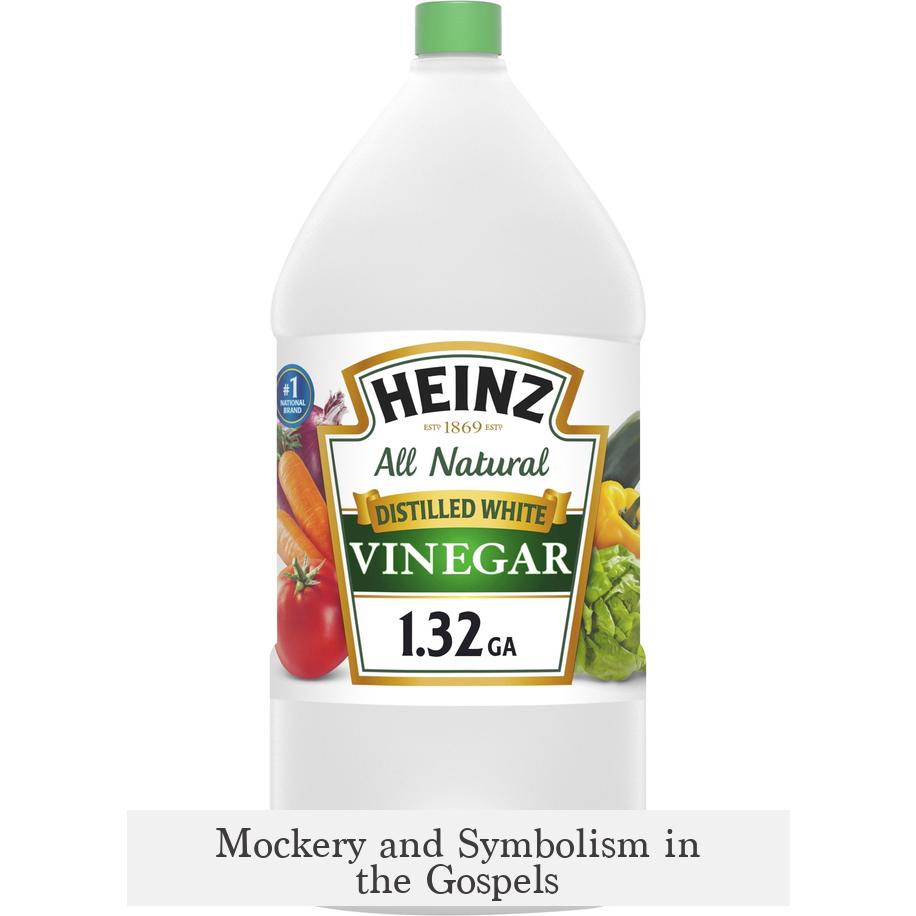The “vinegar” Jesus was given by a Roman soldier during his crucifixion is generally understood to be ὄξος (“oxos” in Greek), a term that commonly referred to vinegar or sour wine. Its precise identity varies among the Gospel accounts. The significance of this drink lies both in its physical and symbolic roles within the Passion narrative, reflecting elements of suffering, prophecy fulfillment, and Roman crucifixion practices.
The Greek word ὄξος literally means vinegar, but its usage in ancient texts was broader and somewhat fluid. It could refer to true vinegar, which is sour wine that has fully fermented and turned acidic, or to soured or inferior wine. This ambiguity is reflected in the Gospel texts, which were written in Koine Greek, a common dialect not always precise in terminology. In Latin, the equivalent term was “acetum.”
True vinegar was a known medicinal substance in antiquity. According to Dioscorides in *De medica materia* V.13, vinegar cooled and contracted bodily tissues, helped staunch bleeding, and was often used to treat wounds and inflammations. In the context of Jesus’ crucifixion, the vinegar might have been offered as a crude form of medical care to mitigate bleeding wounds. However, crucifixion was designed as a prolonged, torturous form of death involving exposure, exhaustion, and suffocation. Thus, while vinegar could help stop bleeding, it might have accelerated Jesus’ death by hastening exhaustion.
The Gospel narratives, however, present conflicting contexts for the offering of the vinegar. Luke depicts the act as part of the soldiers’ mockery of Jesus as “King of the Jews,” linking it to a mocking offering of a bitter drink. In contrast, Matthew and Mark describe an earlier episode where Jesus is given a drink of wine mixed with bitter substances like myrrh, a costly aromatic used in burial preparations but without notable pain relief effects. This wine mixture was likely symbolic — an expensive wine offered mockingly, akin to the crown of thorns and purple robe, representing ironic homage to a “king.”
The vinegar offered later differs in its role and symbolism. All four Gospels mention the vinegar-like drink, though John uniquely places it in response to Jesus’ declaration, “I thirst,” emphasizing the human reality of suffering. This moment also fulfills Psalm 69:21 explicitly quoted in the New Testament. The Psalm reads:
“They gave me poison (χολὴν) for food, and for my thirst they gave me vinegar (ὄξος) to drink.”
This Old Testament reference underscores the prophetic dimension of the event, presenting the offering as a fulfillment of messianic suffering foretold in Scripture.
Harmonizing the Gospel differences is challenging. Matthew and Mark double the incident of offering drinks, suggesting two traditions combined in their accounts. The original tradition likely included the offering of ὄξος alone, though it remains unclear if it was meant as a gesture of kindness, simple thirst relief, or further mockery. John’s account presents it as a factual response to Jesus’ thirst, while Luke frames it as part of derision.
The type of drink may have been posca, a common diluted vinegar beverage favored by Roman soldiers and the poor. Posca was made by mixing water, vinegar, and sometimes herbs. Its low quality contrasts with the costly myrrh wine that was offered earlier for mockery. The Gospel writers may have used ὄξος loosely, not distinguishing between vinegar proper and sour or poor-quality wine. The offering was practical as a thirst-quencher under Roman execution conditions but also oppressive given the drink’s acid nature and bitterness.
The intentions behind giving Jesus vinegar are ambiguous. The medical interpretation suggests a crude analgesic or bleeding control attempt, though such aid is inconsistent with the brutal goals of crucifixion. The mockery interpretation aligns with Roman soldiers’ behavior, using the vinegar to ridicule Jesus’ claim to kingship. John’s narrative leans toward the natural human aspect of Jesus’ thirst, and the fulfillment of prophetic scripture gives the event theological depth.
In short, the vinegar Jesus received was likely a sour, vinegary drink, either true vinegar used medicinally or a cheap, sour wine such as posca. It symbolized his suffering and fulfilled messianic prophecy. It also highlighted the cruelty and mockery surrounding the crucifixion—Jesus left with nothing but bitter drink at his final moments.
| Aspect | Details |
|---|---|
| Term Used | ὄξος (oxos) – vinegar or sour wine |
| Type of Drink | True vinegar (medicinal) or sour/poor wine (posca) |
| Possible Purpose | Thirst relief, wound treatment, mockery |
| Biblical Context | Fulfillment of Psalm 69:21 prophecy |
| Gospel Differences | Luke – part of mockery; John – response to thirst; Matthew/Mark – mixed accounts |
- The vinegar was likely a sour or vinegared wine, termed ὄξος in Greek.
- It could have been medicinal vinegar, a common wound treatment in Roman times.
- Gospels differ: some depict it as mocking, others as an act to quench thirst.
- The offering fulfills messianic prophecy from Psalm 69:21.
- The drink symbolizes Jesus’ physical suffering and humiliation during crucifixion.
What Was the “Vinegar” Jesus Was Given to Drink by a Roman Soldier During His Crucifixion? And What’s Its Significance?

The “vinegar” Jesus was given to drink during his crucifixion, described in the Gospels as ὄξος (oxos) in Greek, refers broadly to a sour liquid, which could mean true vinegar, soured wine, or a diluted vinegar-based drink like posca. The exact nature of this drink remains debated and its significance multifaceted — it blends practical, symbolic, and prophetic meanings.
Let’s dig into this fascinating detail from the crucifixion scene—often overlooked but loaded with layers of meaning.
The Mysterious Drink: Vinegar, Sour Wine, or Something Else?
When the Gospels mention ὄξος (oxos) given to Jesus, it literally means vinegar in Greek. But ancient vinegar wasn’t just salad dressing; it was typically made from old wine that had soured. This means oxos could be any number of drinks along the spectrum of “old, sour wine” to “true vinegar.” The writers weren’t obsessed with scientific precision; their language was flexible based on everyday usage.
In Latin, the same substance was called acetum, which, much like today, could refer to anything from sharp vinegar to cheap or spoiled wine.
A Medicinal Drink or a Cruel Gesture?
True vinegar had a practical use in the ancient world. It functioned as medicine, a known astringent that stopped bleeding and soothed wounds. Dioscorides, a renowned ancient physician, famously noted vinegar “cooling and contracting” wounds and staunching hemorrhages. Given Jesus’ brutal beating and the nature of crucifixion wounds, it’s plausible that Roman soldiers offered vinegar to help with his bleeding.
Yet here’s the twist: crucifixion was meant to be slow, torturous death. So, rather than saving Jesus, the vinegar might have hastened his end by aggravating his wounds or dehydrating him further. This makes the offer ambiguous—was it mercy or a final act of cruelty?
Mockery and Symbolism in the Gospels

The Gospel writers don’t exactly agree on the context of the vinegar-drinking incident.
- Luke presents the vinegar as part of a mocking gesture by Roman soldiers, poking fun at Jesus as “King of the Jews.”
- Other Gospels reference a bitter wine mixture—possibly myrrh or another expensive aromatic wine—offered as a mocking “gift.”
This suggests that the vinegar wasn’t simply medicinal but also part of a carefully crafted insult—a bitter, cheap mockery shadowing the expensive props like the purple cloak and crown used to ridicule Jesus’ kingship.
The Psalm 69 Connection: A Prophecy Fulfilled?
“They gave me poison (χολὴν) for food, and for my thirst they gave me vinegar (ὄξος) to drink.” — Psalm 69:21 (LXX)
This Old Testament verse resonates loudly with the Gospel accounts. The Greek Septuagint (the version New Testament writers most often quoted) uses the precise word oxos for vinegar. This link shows the Gospel authors weaving Jesus’ suffering into ancient prophecy, deepening the tragic symbolism of the vinegar given to him.
Gospel Disagreements and Possible Harmonizations
Matthew and Mark both mention two separate drink offerings, which is unusual. This doubling points to two different oral traditions combined into the written texts. Scholars believe the original drink offered was simply ὄξος (oxos), but they can’t be sure if it was earnest help or part of the humiliation.
John is unique—he records Jesus asking for drink, and then receiving vinegar, highlighting a thirst-quenching gesture. In contrast, the other Gospels only mention the drink being offered with no explicit request, leaving room for interpretation.
What Exactly Did Jesus Drink? Enter Posca

If the drink wasn’t pure vinegar (which would be harsh), it might have been posca—a common Roman soldier’s drink made by diluting vinegar with water and flavoring it with herbs. Posca was sour but refreshing, far cheaper than wine, and a staple of the working class and army.
Ancient texts mention posca as loved by all social classes, from poor workers to austere aristocrats like Cato the Elder. The Gospel writers probably used the broad term oxos loosely, not distinguishing between posca, sour wine, or vinegar.
Unclear Intentions: Hydration or Humiliation?
The meaning behind offering vinegar/posca to Jesus during his crucifixion is ambiguous:
- Luke’s view: It’s a cruel insult, part of the soldiers’ mockery, reflecting true vinegar used medicinally but here serving to scorn rather than soothe.
- John and others: It might be a simple, cheap hydration offered to a thirsty condemned man.
Either way, the drink highlights Jesus’ suffering and desperation. The ambiguity deepens the drama. Was it a last act of basic kindness or the final twist in a sequence of humiliations? It’s like a thorn in our understanding, forcing us to look closer.
What Can We Take Away from This?
Understanding what “vinegar” Jesus drank isn’t just trivia; it reveals:
- The harsh realities of crucifixion: Desperate thirst, brutal wounds, and slow suffering punctuated even by obscure gestures like a sour drink.
- The multi-layered symbolism: This isn’t just physical suffering but a fulfillment of prophetic Scripture.
- Historical texture: A peek into Roman practices—how soldiers might offer posca to soldiers or prisoners, intertwining practical care with derision.
Plus, it challenges readers to think about mercy, cruelty, and the nuances in ancient storytelling. Did the soldiers intend mercy? Or was it the cruelest gesture of all, shrouded in the guise of drink?
Final Thoughts: Beyond the Vinegar
So next time you hear about Jesus being offered vinegar on the cross, remember: that “vinegar” could have been a bitter symbol, a healing agent, a humble soldier’s drink, or all three. The small detail opens a window into the ancient world’s texture, the deep layers of meaning in the Gospels, and the enduring mystery surrounding one of history’s most pivotal moments.
Maybe it’s uncomfortable to think about, but sometimes history’s bitter sips hold the most profound insights.




